Development of an Approach for the Holistic Assessment of Innovation Projects in Manufacturing Including Potential, Effort, and Risk Using a Systematic Literature Review and Expert Interviews
Abstract
:1. Introduction and Motivation
2. Fundamentals of Innovation Assessment in Manufacturing
3. State of the Art
4. Methodical Approach
5. Developing the Approach for the Assessment of Innovation Projects in Manufacturing
5.1. Phase I: Criteria Derivation for Innovation Project Assessment in Manufacturing
5.2. Phase II: Approach Development for Holistic Innovation Assessment in Manufacturing
5.3. Phase III: Initial Application
6. Implications of Findings
- Point 1—Extension and further specification of the assessment criteria: With the constant change and enhancement of target dimensions within manufacturing as well as the release of innovative and complex technologies the assessment criteria selection must be continuously adapted. Further, to enable the ongoing development of the Industry 5.0 concept, emerging potentials, efforts, and risks may need to be integrated into the assessment approach to enable an evaluation that not primarily aims at increasing cost-efficiency but also includes workers, consumers, society, and the environment. Additionally, Key Performance Indicators (KPI) could specify the assessment criteria. By setting up a KPI model for each criterion, the changes within the respective dimension could be indicated more precisely.
- Point 2—Further inclusion of cause-effect relationships: Cause-effect relationships between the potential or effort targets and the company’s strategic goals could be integrated to elaborate the model perspective towards a broader, stakeholder-focused analysis.
- Point 3—Further industrial validation: The approach should be validated with the help of other use cases from different industries and the representation of group decision scenarios. On this basis, the theoretical strengths of the approach could be validated and potential starting points for further development work could be identified.
7. Conclusions
Author Contributions
Funding
Institutional Review Board Statement
Informed Consent Statement
Data Availability Statement
Acknowledgments
Conflicts of Interest
References
- Mack, O.; Khare, A. Perspectives on a VUCA World. In Managing in a VUCA World; Mack, O., Khare, A., Krämer, A., Burgartz, T., Eds.; Springer International Publishing: Cham, Switzerland, 2016; pp. 3–19. [Google Scholar]
- Hofer, A.; Brandl, F.J.; Bauer, H.; Haghi, S.; Reinhart, G. A Framework for Managing Innovation Cycles in Manufacturing Systems. Procedia CIRP 2020, 93, 771–776. [Google Scholar] [CrossRef]
- Becattini, N.; Cascini, G.; Pierluigi, P.; Pucciarini, A. Production Processes Modeling for Identifying Technology Substitution Opportunities. Procedia Eng. 2015, 131, 14–29. [Google Scholar] [CrossRef] [Green Version]
- Cagliano, A.C.; Mangano, G.; Rafele, C. Determinants of digital technology adoption in supply chain. An exploratory analysis. Supply Chain Forum Int. J. 2021, 22, 100–114. [Google Scholar] [CrossRef]
- Hofer, A.; Schnell, J.; Beck, B.; Reinhart, G. Potential-based technology planning for production companies. Procedia CIRP 2019, 81, 1400–1405. [Google Scholar] [CrossRef]
- Rebentisch, E.; Schuh, G.; Rudolf, S.; Breunig, S.; Brakemeier, C. Technology Assessment for Modular Product Platforms with Fuzzy Numbers. Procedia CIRP 2016, 50, 601–606. [Google Scholar] [CrossRef] [Green Version]
- Breque, M.; de Nul, L.; Petridis, A. Industry 5.0: Towards a Sustainable, Human-Centric and Resilient European Industry; European Commission: Brussels, Belgium, 2022.
- Millen, R.; Sohal, A.S. Planning processes for advanced manufacturing technology by large American manufacturers. Technovation 1998, 18, 741–750. [Google Scholar] [CrossRef]
- Greitemann, J.; Hehl, M.; Wagner, D.; Reinhart, G. Scenario and roadmap-based approach for the analysis of prospective production technology needs. Prod. Eng. 2016, 10, 337–343. [Google Scholar] [CrossRef]
- Greitemann, J.; Zaggl, M.A.; Hehl, M.; Raasch, C.; Reinhart, G. Technology lifecycle-oriented search for production technologies. CIRP J. Manuf. Sci. Technol. 2017, 16, 21–33. [Google Scholar] [CrossRef]
- Schuh, G.; Scholz, P.; Seichter, S.; Schuh, G. Identification of Indicators for the Assessment of Technological Risks within Technology Selection. In Proceedings of the 2020 61st International Scientific Conference on Information Technology and Management Science of Riga Technical University (ITMS), Riga, Latvia, 15–16 October 2020; pp. 1–8. [Google Scholar] [CrossRef]
- Arnal, Á.; Dıáz-Ramırez, M.; Acevedo, L.; Ferreira, V.J.; Garcıá-Armingol, T.; LópezSabiron, A.M.; Ferreira, G. Multicriteria analysis for retrofitting of natural gas melting and heating furnaces for sustainable manufacturing and Industry 4.0. ASME J. Energy Resour. Technol. 2020, 142, 022203. [Google Scholar] [CrossRef] [Green Version]
- Essakly, A.; Wichmann, M.; Spengler, T.S. A reference framework for the holistic evaluation of Industry 4.0 solutions for small- And medium-sized enterprises. IFAC-PapersOnLine 2019, 52, 427–432. [Google Scholar] [CrossRef]
- Schumpeter, J.A. Konjunkturzyklen: Eine Theoretische, Historische und Statistische Analyse des Kapitalistischen Prozesses; Vandenhoek & Ruprecht: Göttingen, Germany, 1961. [Google Scholar]
- Brandl, F.J.; Kagerer, M.; Reinhart, G. A Hybrid Innovation Management Framework for Manufacturing—Enablers for more Agility in Plants. Procedia CIRP 2018, 72, 1154–1159. [Google Scholar] [CrossRef]
- Gärtner, Q.; Hofer, A.; Reinhart, G. Identification and systematization of strategic technology demands in manufacturing. Procedia CIRP 2021, 104, 32–37. [Google Scholar] [CrossRef]
- Shen, K.-Y.; Tzeng, G.-H. Advances in Multiple Criteria Decision Making for Sustainability: Modeling and Applications. Sustainability 2018, 10, 1600. [Google Scholar] [CrossRef] [Green Version]
- Saaty, T.L. The Analytic Hierarchy and Analytic Network Processes for the Measurement of Intangible Criteria and for Decision-Making. Int. Ser. Oper. Res. Manag. Sci. 2016, 233, 363–419. [Google Scholar] [CrossRef]
- Figueira, J.R.; Mousseau, V.; Roy, B. ELECTRE Methods. Mult. Criteria Decis. Anal. 2016, 233, 155–185. [Google Scholar] [CrossRef]
- Brans, J.-P.; de Smet, Y. PROMETHEE Methods. Mult. Criteria Decis. Anal. 2016, 233, 187–219. [Google Scholar] [CrossRef]
- Hwang, C.-L.; Yoon, K. Multiple Attribute Decision Making: Methods and Applications; Springer: Berlin/Heidelberg, Germany, 1981; ISBN 978-3-642-48318-9. [Google Scholar]
- Zadeh, L.A. Fuzzy logic—A personal perspective. Fuzzy Sets Syst. 2015, 281, 4–20. [Google Scholar] [CrossRef]
- de Barros, L.C.; Bassanezi, R.C.; Lodwick, W.A. A First Course in Fuzzy Logic, Fuzzy Dynamical Systems, and Biomathematics: Theory and Applications; Springer: Berlin/Heidelberg, Germany, 2017; ISBN 9783662533246. [Google Scholar]
- Rangone, A. A reference framework for the application of the fuzzy set theory to the assessment of investments in advanced manufacturing technologies. In Proceedings of the 1995 IEEE International Conference on Systems, Man and Cybernetics, Vancouver, BC, Canada, 22–25 October 1995; Volume 3, pp. 2880–2885. [Google Scholar] [CrossRef]
- Liu, Y.; Eckert, C.M.; Earl, C. A review of fuzzy AHP methods for decision-making with subjective judgements. Expert Syst. Appl. 2020, 161, 113738. [Google Scholar] [CrossRef]
- Ulich, E. Man—Technology—Organization: An European production concept. Concr. Precast. Plant Technol. 1999, 65, 26–31. [Google Scholar]
- Rowley, J.; Keegan, B.J. An overview of systematic literature reviews in social media marketing. J. Inf. Sci. 2020, 46, 725–738. [Google Scholar] [CrossRef] [Green Version]
- Watson, R.T.; Webster, J. Analysing the past to prepare for the future: Writing a literature review a roadmap for release 2.0. J. Decis. Syst. 2020, 29, 129–147. [Google Scholar] [CrossRef]
- Schuh, G.; Scholz, P.; Latz, T. Determining the strategic potential of technologies for manufacturing companies. Vorausschau Technol. 2021, 17, 471–494. [Google Scholar]
- Schuh, G.; Scholz, P. Risk and potential evaluation of technologies in the early stages of the innovation process. Vorausschau Technol. 2019, 15, 381–400. [Google Scholar]
- Hofer, A.; Pemsel, B.; Putz, M. Potential-based Evaluation of Innovative Technologies in Production. Z. Wirtsch. Fabr. 2021, 116, 294–298. [Google Scholar] [CrossRef]
- Larsson, L.; Stahre, J.; Warrol, C.; Rönnbäck, A.Ö. An Assessment Model for Production Innovation: The Program Production 2030. Procedia Manuf. 2018, 25, 134–141. [Google Scholar] [CrossRef]
- Farooq, S.; O’Brien, C. Risk calculations in the manufacturing technology selection process. J. Manuf. Technol. Manag. 2010, 21, 28–49. [Google Scholar] [CrossRef]
- Ordoobadi, S.M. Fuzzy logic and evaluation of advanced technologies. Ind. Manage. Data Syst. 2008, 108, 928–946. [Google Scholar] [CrossRef]
- Schöning, S. Potenzialbasierte Bewertung Neuer Technologien. Ph.D. Dissertation, RWTH Aachen, Aachen, Germany, 2006. [Google Scholar]
- Hall, K. Ganzheitliche Technologiebewertung: Ein Modell zur Bewertung Unterschiedlicher Produktionstechnologien. Ph.D. Dissertation, Universität Leoben, Leoben, Austria, 2002. [Google Scholar]
- Yap, C.M.; Souder, W. A filter system for technology evaluation and selection. Technovation 1993, 13, 449–469. [Google Scholar] [CrossRef]
- Servatius, H.-G.; Peiffer, S. Ganzheitliche und Evolutionäre Technologiebewertung. In Technologiefrühaufklärung; VDI-Technologiezentrum, Ed.; Schäffer-Poeschel Verlag: Stuttgart, Germany, 1992; pp. 73–98. [Google Scholar]
- Kröger, S.; Bauer, H.; Reinhart, G. Cost Structure for Change Impact Evaluation in Manufacturing Systems. Z. Wirtsch. Fabr. 2019, 114, 530–534. [Google Scholar] [CrossRef]
- Bauer, H.; Schönmann, A.; Reinhart, G. Approach for model-based change impact analysis in factory systems. In Proceedings of the 2017 IEEE International Systems Engineering Symposium (ISSE), Vienna, Austria, 11–13 October 2017; Volume 1, pp. 1–7. [Google Scholar] [CrossRef]
- Plehn, C.; Stein, F.; de Neufville, R.; Reinhart, G. Assessing the Impact of Changes and their Knock-on Effects in Manufacturing Systems. Procedia CIRP 2016, 57, 479–486. [Google Scholar] [CrossRef]
- Cichos, D.; Aurich, J.C. Planning and Controlling of Multiple, Parallel Engineering Changes in Manufacturing Systems. Procedia CIRP 2015, 33, 81–86. [Google Scholar] [CrossRef] [Green Version]
- Malak, R.C.; Aurich, J.C. Software Tool for Planning and Analyzing Engineering Changes in Manufacturing Systems. Procedia CIRP 2013, 12, 348–353. [Google Scholar] [CrossRef]
- Brönner, M. Decision-Support for Production Strategies for Developing Economies. Doctoral dissertation, Technical University of Munich, Munich, Germany, 2020. [Google Scholar]
- Krebs, P.; Reinhart, G. Evaluation of interconnected production sites taking into account multidimensional uncertainties. Prod. Eng. 2012, 6, 587–601. [Google Scholar] [CrossRef]
- Arabshahi, H.; Fazlollahtabar, H. Risk analysis for innovative activities in production systems using product opportunity gap concept. TQM J. 2019, 31, 1028–1048. [Google Scholar] [CrossRef]
- Eßer, G.; Brykczynski, G.; Hipp, C. Management von Produktionsinnovationen mit TREX. Z. Wirtsch. Fabr. 2016, 111, 671–675. [Google Scholar] [CrossRef]
- Liang, C.; Li, Q. Enterprise information system project selection with regard to BOCR. Int. J. Project Manage. 2008, 26, 810–820. [Google Scholar] [CrossRef]
- Granig, P. Innovationsbewertung: Potentialprognose und -steuerung durch Ertrags- und Risikosimulation. Ph.D. Dissertation, Universität Klagenfurt, Klagenfurt, Austria, 2005. [Google Scholar]
- Sambasivarao, K.V.; Deshmukh, S.G. A decision support system for selection and justification of advanced manufacturing technologies. Prod. Plann. Control 1997, 8, 270–284. [Google Scholar] [CrossRef]
- Schuh, G.; Scholz, P.; Ando, Y.-S. Assessing the application based utility potential of new technologies. In Proceedings of the 2020 IEEE Technology & Engineering Management Conference (TEMSCON), Novi, MI, USA, 3–6 June 2020; pp. 1–8. [Google Scholar] [CrossRef]
- Deutsches Institut für Normung. DIN 55350 Begriffe zum Qualitätsmanagement; Beuth: Berlin, Germany, 2021; pp. 1–48. [Google Scholar]
- Li, G. Research on the Investment Decision-Making on the Application of Advanced Manufacturing Technologies in Enterprises. Adv. Mater. Res. 2011, 323, 60–64. [Google Scholar] [CrossRef]
- Westkämper, E. Einführung in die Organisation der Produktion; Springer: Berlin/Heidelberg, Germany, 2006; ISBN 9783540260394. [Google Scholar]
- Erlach, K. Wertstromdesign: Der Weg zur schlanken Fabrik; Springer: Berlin/Heidelberg, Germany, 2020; ISBN 978-3-662-58906-9. [Google Scholar]
- Geisler, E. Creating Value with Science and Technology; QUORUM Books: Westport Connecticut, CT, USA, 2001; ISBN 978-1567204056. [Google Scholar]
- Deutsches Institut für Normung. DIN 8743 Verpackungsmaschinen und Verpackungsanlagen; Beuth: Berlin, Germany, 2014; pp. 1–26. [Google Scholar]
- Zäh, M.F.; Müller, N.; Prasch, M.; Sudhoff, W. Methodik zur Erhöhung der Wandlungsfähigkeit von Produktionssystemen. Z. Wirtsch. Fabr. 2004, 99, 173–177. [Google Scholar] [CrossRef]
- Sethi, A.; Sethi, S. Flexibility in manufacturing: A survey. Int. J. Flexible Manuf. Syst. 1990, 2, 289–328. [Google Scholar] [CrossRef]
- Korder, S.; Krauel, M.; Vernim, S.; Reinhart, G. Identification of workplace-related turnover predictors in production. Procedia CIRP 2021, 104, 1476–1481. [Google Scholar] [CrossRef]
- Deutsches Institut für Normung. DIN EN ISO 10075-1 Teil 1: Ergonomische Grundlagen Bezüglich Psychischer Arbeitsbelastung: Allgemeine Aspekte und Konzepte und Begriffe; Beuth: Berlin, Germany, 2018; pp. 1–19. [Google Scholar]
- Schneider, D.; Paul, M.; Vernim, S.; Zäh, M.F. Sustainability Assessment of Manufacturing Systems—A Review-Based Systematisation. Proceedings CARV 2022, 1, 1023–1030. [Google Scholar] [CrossRef]
- Cooper, R.G. Managing technology development projects. IEEE Eng. Manag. Rev. 2007, 35, 67. [Google Scholar] [CrossRef]
- Forno, A.J.D.; Pereira, F.A.; Forcellini, F.A.; Kipper, L.M. Value Stream Mapping: A study about the problems and challenges found in the literature from the past 15 years about application of Lean tools. Int. J. Adv. Manuf. Technol. 2014, 72, 779–790. [Google Scholar] [CrossRef]
- Knoll, D.; Reinhart, G.; Prüglmeier, M. Enabling value stream mapping for internal logistics using multidimensional process mining. Expert Syst. Appl. 2019, 124, 130–142. [Google Scholar] [CrossRef]
- Pfeffer, M. Bewertung von Wertströmen; Springer Fachmedien Wiesbaden: Wiesbaden, Germany, 2014. [Google Scholar]
- Spur, G.; Eßer, G.; Brykczynski, G. Risikomanagement produktionstechnischer Innovationen. Z. Wirtsch. Fabr. 2012, 107, 485–488. [Google Scholar] [CrossRef]
- Cagliano, A.C.; Grimaldi, S.; Rafele, C. Choosing project risk management techniques. A theoretical framework. J. Risk Res. 2015, 18, 232–248. [Google Scholar] [CrossRef] [Green Version]
- Spur, G.; Eßer, G. Produktionsinnovationen als unternehmerische Herausforderung. Z. Wirtsch. Fabr. 2010, 105, 763–766. [Google Scholar] [CrossRef]
- Adams, W.C. Conducting Semi-Structured Interviews. In Handbook of Practical Program Evaluation; Newcomer, K.E., Hatry, H.P., Wholey, J.S., Eds.; John Wiley & Sons, Inc: Hoboken, NJ, USA, 2015; pp. 492–505. [Google Scholar]
- Pfeffer, M.; Gottmann, J. Chancen nutzen in Krisenzeiten durch Produktionsoptimierung. Z. Wirtsch. Fabr. 2009, 104, 358–361. [Google Scholar] [CrossRef]
- Kern, S. Produktions-Controlling für Fertigungsinseln. Ph.D. Dissertation, Universität Saarbrücken, Saarbrücken, Germany, 1993. [Google Scholar]
- Gottmann, J.; Pfeffer, M.; Sihn, W. Process Oriented Production Evaluation. Procedia CIRP 2013, 12, 336–341. [Google Scholar] [CrossRef]
- Arnold, D.; Isermann, H.; Kuhn, A.; Tempelmeier, H.; Furmans, K. (Eds.) Handbuch Logistik; Springer: Berlin/Heidelberg, Germany, 2008; ISBN 9781281276100. [Google Scholar]
- Pérez-Fernández, L.; Sebastián, M.A.; González-Gaya, C. Methodology to Optimize Quality Costs in Manufacturing Based on Multi-Criteria Analysis and Lean Strategies. Appl. Sci. 2022, 12, 3295. [Google Scholar] [CrossRef]
- Dyckhoff, H.; Spengler, T.S. Produktionswirtschaft; Springer Berlin Heidelberg: Berlin/Heidelberg, Germany, 2010; ISBN 9783642136849. [Google Scholar]
- Palupski, R. Management von Beschaffung, Produktion und Absatz; Gabler Verlag: Wiesbaden, Germany, 2002. [Google Scholar]
- Liebermann, M. Sunk Costs. In The Palgrave Encyclopedia of Strategic Management; Augier, M., Teece, D.J., Eds.; Palgrave Macmillan: London, UK, 2016; pp. 1–3. [Google Scholar]
- Cagliano, A.C.; de Marco, A.; Grimaldi, S.; Rafele, C. An integrated approach to supply chain risk analysis. J. Risk Res. 2012, 15, 817–840. [Google Scholar] [CrossRef] [Green Version]
- Saaty, T.L.; Shang, J.S. An innovative orders-of-magnitude approach to AHP-based mutli-criteria decision making: Prioritizing divergent intangible humane acts. Eur. J. Oper. Res. 2011, 214, 703–715. [Google Scholar] [CrossRef]
- Yager, R.R. A procedure for ordering fuzzy subsets of the unit interval. Inf. Sci. 1981, 24, 143–161. [Google Scholar] [CrossRef]
- Wind, Y.; Saaty, T.L. Marketing Applications of the Analytic Hierarchy Process. Manag. Sci. 1980, 26, 641–658. [Google Scholar] [CrossRef]
- Goddard Space Flight Center. Risk Management Reporting GSFC-STD-0002; Goddard Space Flight Center: Greenbelt, MD, USA, 2009.
- Kusumawardani, R.P.; Agintiara, M. Application of Fuzzy AHP-TOPSIS Method for Decision Making in Human Resource Manager Selection Process. Procedia Comput. Sci. 2015, 72, 638–646. [Google Scholar] [CrossRef] [Green Version]

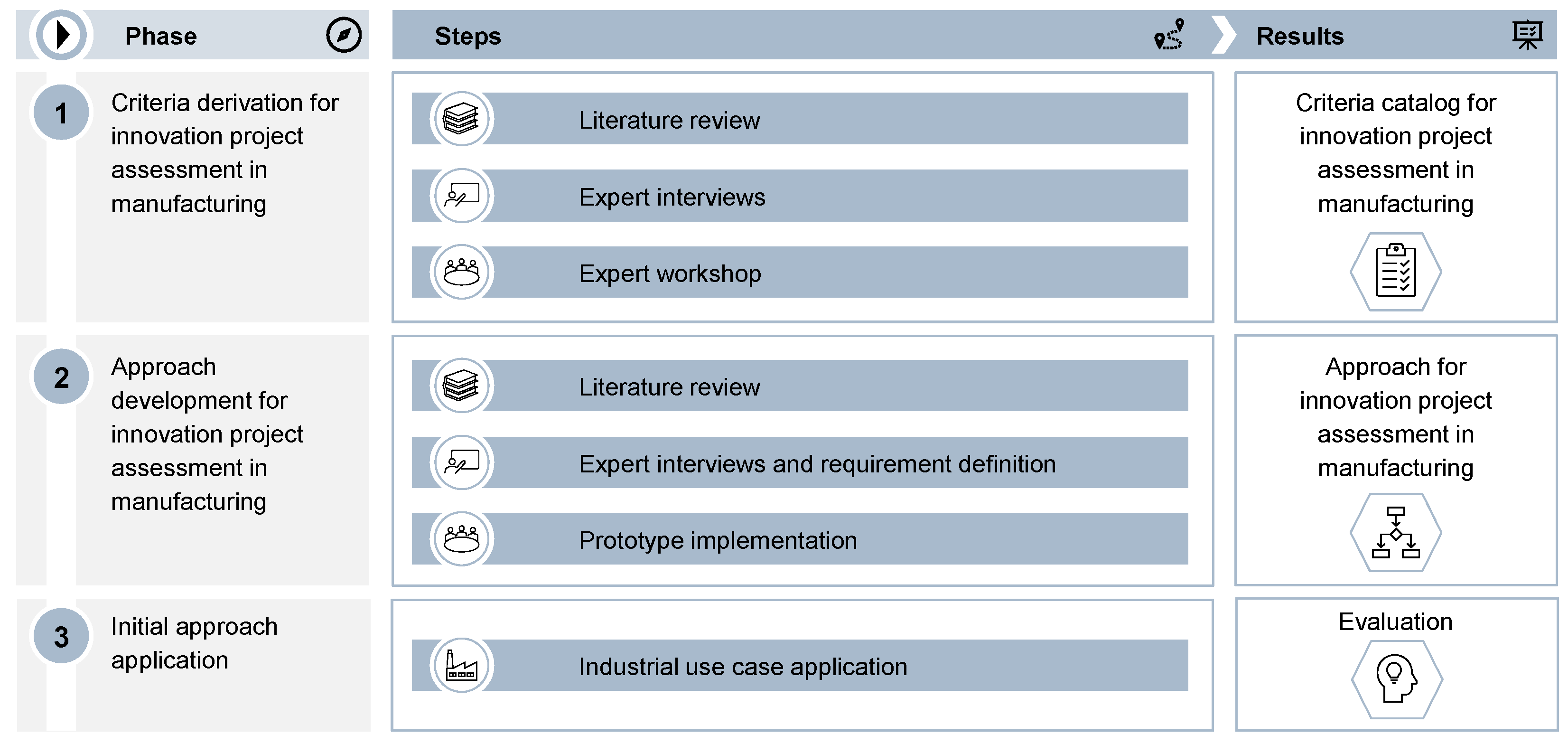

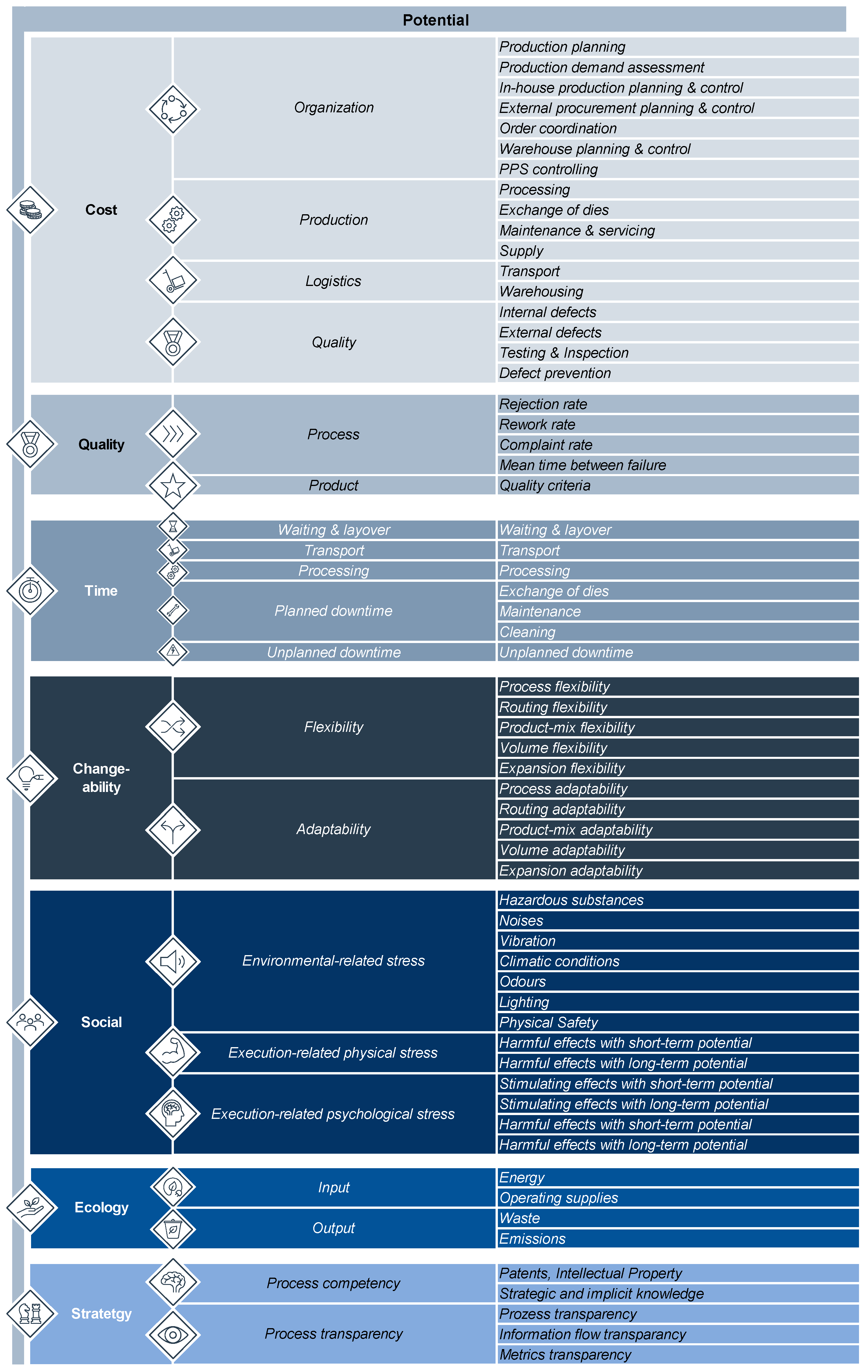
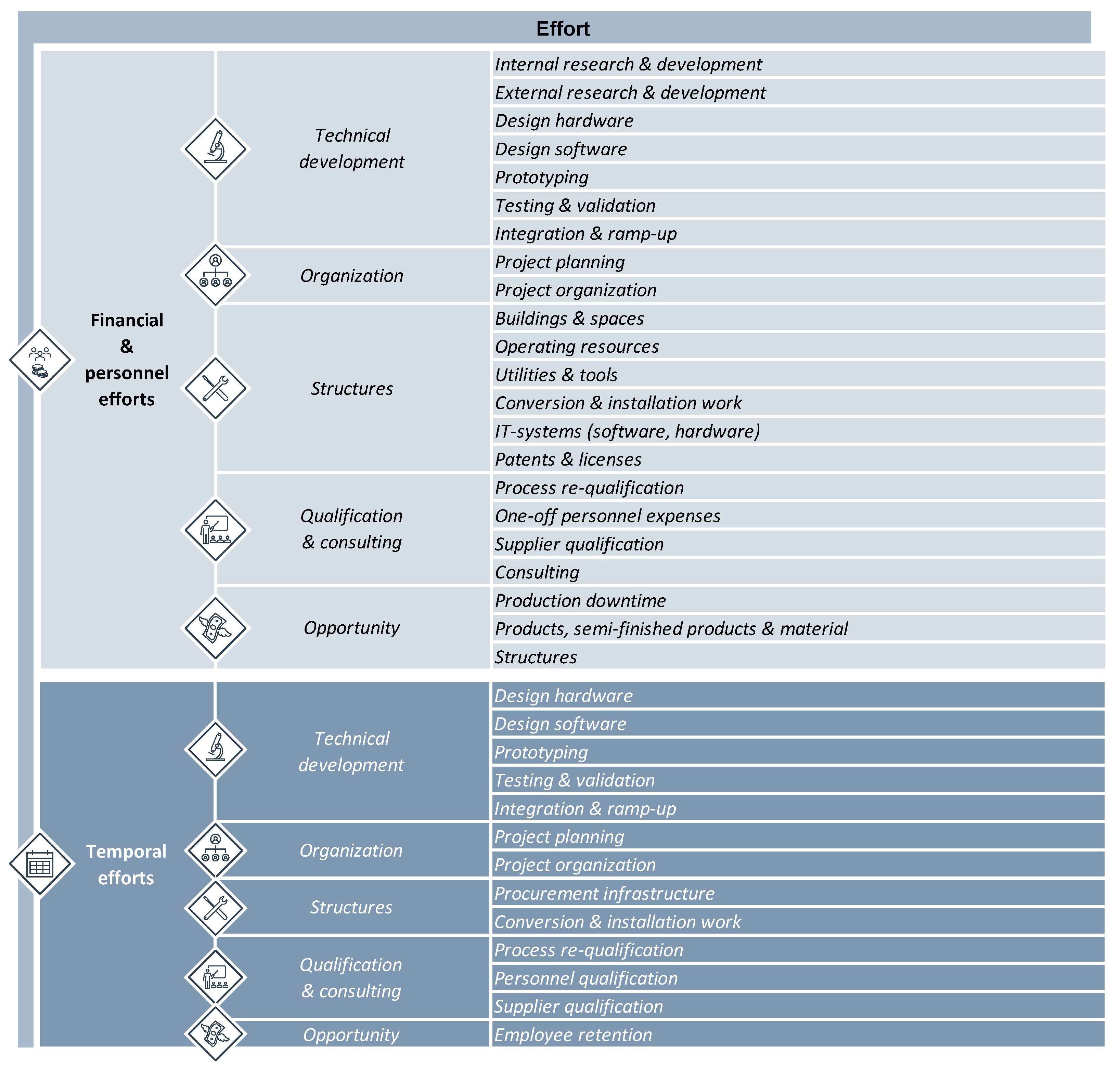
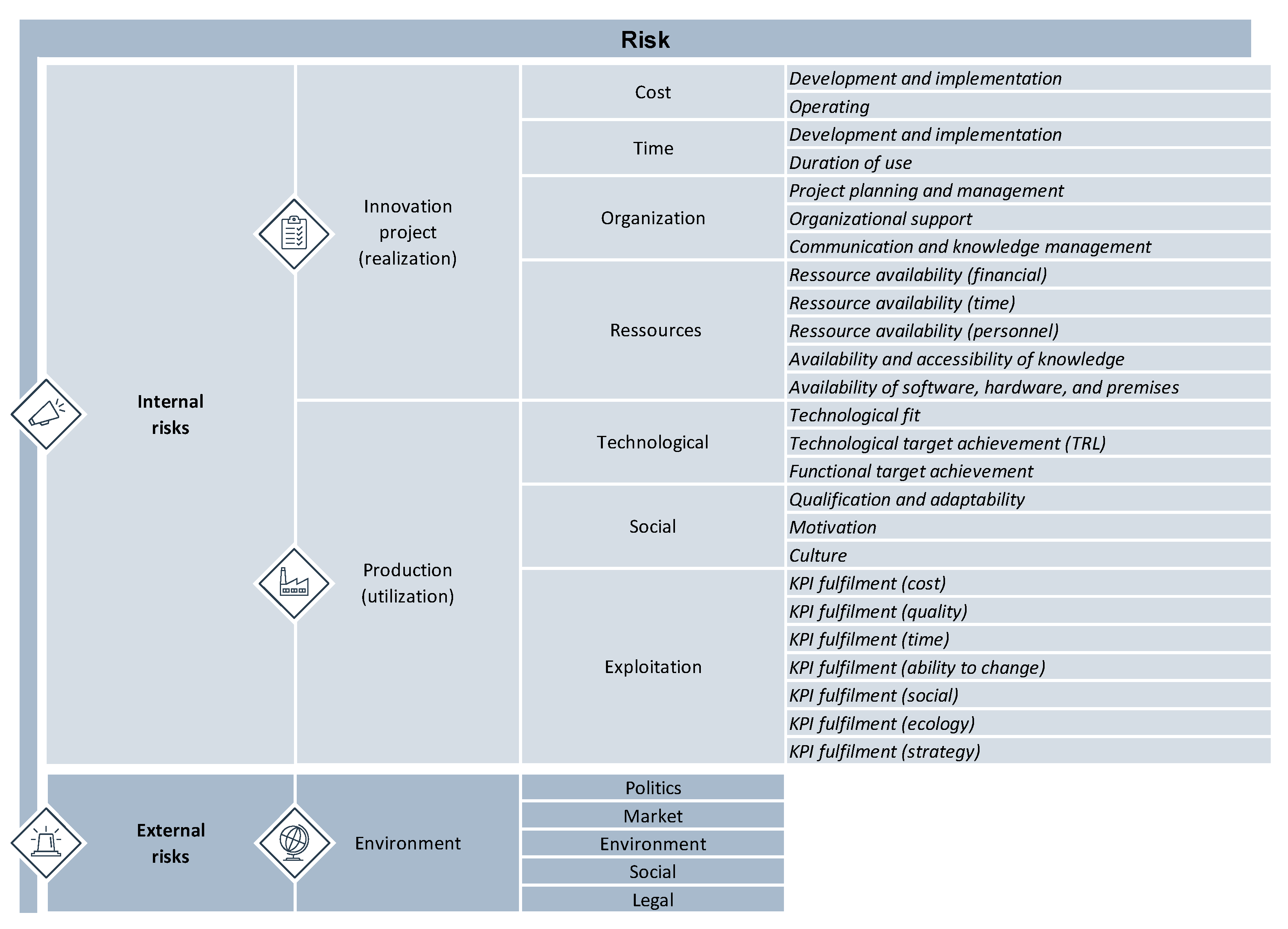

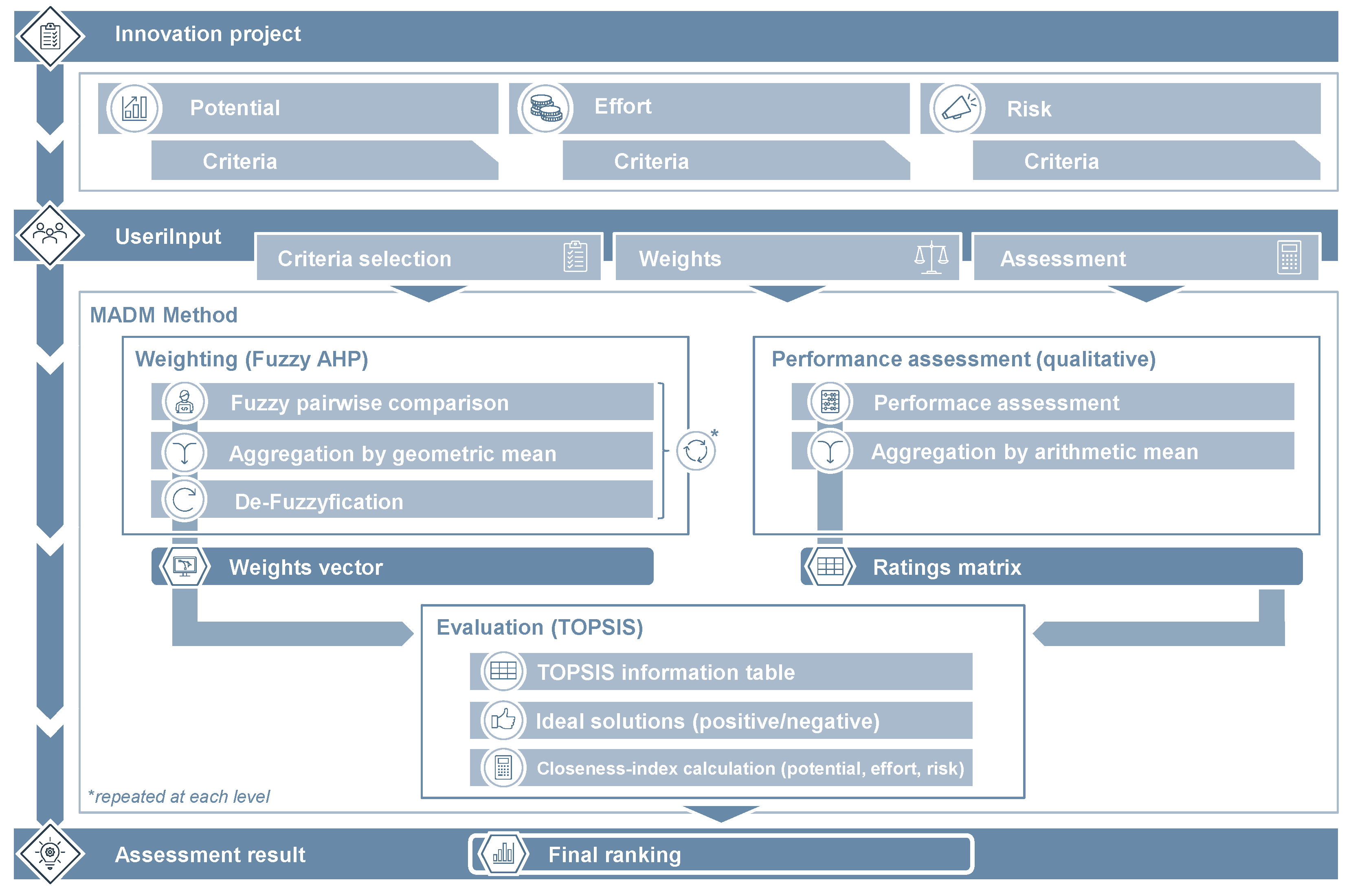
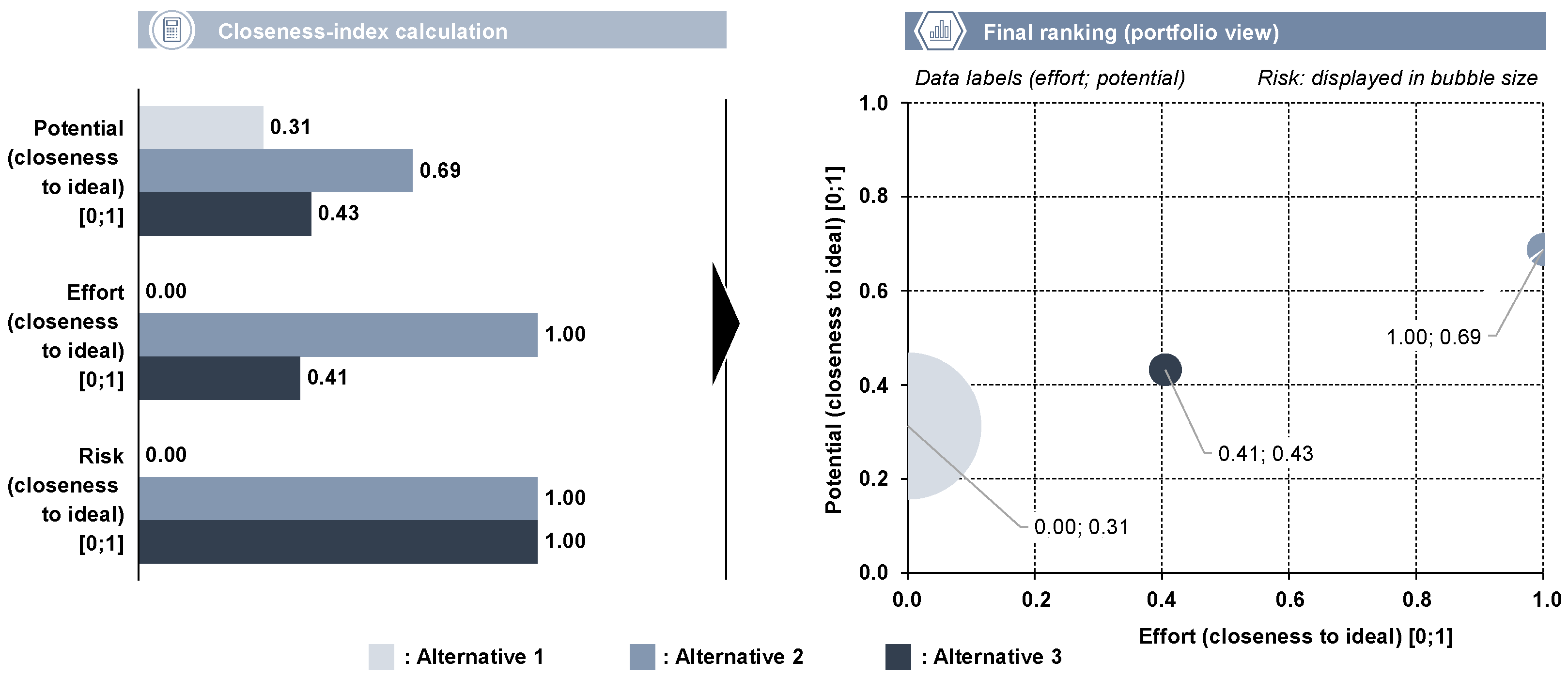
| Inclusion Criteria | Description |
|---|---|
| Search terms | Manufacturing, Production, Process, Technology, Innovation, Assessment, Evaluation, Effort, Risk, Potential, Management |
| Subject area | Decision-making, Risk-assessment, Technology assessment, Decision support systems, Investments, Strategic planning, Performance assessment, Economics, Industrial management, Innovation, Cost–benefit analysis, Technological forecasting, Economic and social effects |
| Year | 1970–2022 |
| Language | English, German |
| Characteristics | |||||||||||||||
|---|---|---|---|---|---|---|---|---|---|---|---|---|---|---|---|
| Focus | Process | Innovation | Criteria | Method | Application | ||||||||||
| Title | Citation | Manufacturing | Early Phase | Human | Technology | Organization | Potential | Effort | Risk | Decision Support | Utility Analysis | Fuzzy | AHP | TOPSIS | Industrial Applicability |
| Production Processes Modeling for Identifying Technology Substitution Opportunities | [3] |  |  |  |  |  |  |  |  |  | |||||
| Technology Assessment for Modular Product Platforms with Fuzzy Numbers | [6] |  |  |  |  |  |  |  | |||||||
| Planning processes for advanced manufacturing technology by large American manufacturers | [8] |  |  |  |  |  |  | ||||||||
| A reference framework for the holistic evaluation of Industry 4.0 solutions for small- And medium-sized enterprises | [13] |  |  |  |  |  |  |  |  |  |  | ||||
| Identification and systematization of strategic technology demands in manufacturing | [16] |  |  |  |  |  |  |  |  | ||||||
| Determining the strategic potential of technologies for manufacturing companies | [29] |  |  |  |  |  |  |  | |||||||
| Risk and potential evaluation of technologies in the early stages of the innovation process | [30] |  |  |  |  |  |  |  |  | ||||||
| Potential-based Evaluation of Innovative Technologies in Production | [31] |  |  |  |  |  |  |  | |||||||
| An Assessment Model for Production Innovation | [32] |  |  |  |  |  |  |  |  | ||||||
| Risk calculations in the manufacturing technology selection process | [33] |  |  |  |  |  |  |  |  |  | |||||
| Fuzzy logic and evaluation of advanced technologies | [34] |  |  |  |  |  |  |  |  | ||||||
| Potential-based assessment of new technologies [ger.] | [35] |  |  |  |  |  |  |  | |||||||
| Holistic technology assessment. A model for the evaluation of different production technologies [ger.] | [36] |  |  |  |  |  |  |  |  | ||||||
| A filter system for technology evaluation and selection | [37] |  |  |  |  |  |  |  |  | ||||||
| Holistic and Evolutionary Technology Assessment [ger.] | [38] |  |  |  |  |  |  |  |  | ||||||
| Cost Structure for Change Impact Evaluation in Manufacturing Systems | [39] |  |  |  |  |  |  |  |  | ||||||
| Approach for model-based change impact analysis in factory systems | [40] |  |  |  |  |  |  | ||||||||
| Assessing the Impact of Changes and their Knock-on Effects in Manufacturing Systems | [41] |  |  |  |  |  |  |  |  | ||||||
| Planning and Controlling of Multiple, Parallel Engineering Changes in Manufacturing Systems | [42] |  |  |  |  |  |  |  |  | ||||||
| Software Tool for Planning and Analyzing Engineering Changes in Manufacturing Systems | [43] |  |  |  |  |  |  |  | |||||||
| Decision-Support for Production Strategies for Developing Economies | [44] |  |  |  |  |  |  |  | |||||||
| Evaluation of interconnected production sites taking into account multidimensional uncertainties | [45] |  |  |  |  |  |  |  |  | ||||||
| Risk analysis for innovative activities in production systems using product opportunity gap concept | [46] |  |  |  |  |  |  |  |  |  | |||||
| Management of production innovations with TREX [ger.] | [47] |  |  |  |  |  |  |  |  | ||||||
| Enterprise information system project selection with regard to BOCR | [48] |  |  |  |  |  |  |  |  |  | |||||
| Innovation assessment: Potential forecasting and control through yield and risk simulation [ger.] | [49] |  |  |  |  |  |  | ||||||||
| A decision support system for selection and justification of advanced manufacturing technologies | [50] |  |  |  |  |  |  |  |  | ||||||
| Legend: |  : fully fulfilled |  : well fulfilled |  : partly fulfilled |  : hardly fulfilled | |||||||||||
| Potential | Effort | Risk | ||||||||||||||
|---|---|---|---|---|---|---|---|---|---|---|---|---|---|---|---|---|
| Title | Citation | Cost | Quality | Time | Flexibility | Social | Ecology | Strategy | Development | Organization | Structure | Qualification & Consulting | Opportunity | Project | Production | External |
| Cost Structure for Change Impact Evaluation in Manufacturing Systems | [39] | X | X | X | X | X | ||||||||||
| Quality management [ger.] | [52] | X | X | |||||||||||||
| Research on the Investment Decision-Making on the Application of Advanced Manufacturing Technologies in Enterprises | [53] | X | X | X | X | X | X | |||||||||
| Production Management. An introduction [ger.] | [54] | X | ||||||||||||||
| Value stream design. The way to lean production [ger.] | [55] | X | X | X | X | |||||||||||
| Creating Value with Science and Technology | [56] | X | ||||||||||||||
| Packaging machines and packaging lines [ger.] | [57] | X | ||||||||||||||
| Methodology for increasing the adaptability of production systems [ger.] | [58] | X | ||||||||||||||
| Flexibility in manufacturing: A survey | [59] | X | ||||||||||||||
| Identification of workplace-related turnover predictors in production | [60] | X | ||||||||||||||
| Ergonomic principles regarding mental workload-General aspects and concepts and terms [ger.] | [61] | X | ||||||||||||||
| Sustainability Assessment of Manufacturing Systems—A Review-Based Systematisation | [62] | X | ||||||||||||||
| Managing technology development projects | [63] | X | ||||||||||||||
| Value Stream Mapping: a study about the problems and challenges found in the literature from the past 15 years about application of Lean tools | [64] | X | ||||||||||||||
| Enabling value stream mapping for internal logistics using multidimensional process mining | [65] | X | ||||||||||||||
| Evaluation of value streams [ger.] | [66] | X | X | X | X | X | ||||||||||
| Risk management of innovation in production [ger.] | [67] | X | X | X | ||||||||||||
| Legend: | X: adressed | [ger.]: german title translated | ||||||||||||||
| Main Criteria | Criteria | Weight (Local) | Sub- Criteria | Weight (Local) | Detail Criteria | Weight (Local) | Weight (Global) | Alternative 1 | Alternative 2 | Alternative 3 |
|---|---|---|---|---|---|---|---|---|---|---|
| Potential | Cost | 0.545 | Organizational costs | 0.193 | Warehouse planning and controlling | 1.000 | 0.105 | 0.000 | 0.000 | −0.500 |
| Production costs | 0.193 | Supply | 1.000 | 0.105 | 0.000 | 0.000 | 2.000 | |||
| Logistic costs | 0.193 | Transport | 0.500 | 0.053 | −3.000 | −1.500 | −3.000 | |||
| Warehousing | 0.500 | 0.053 | −0.500 | 0.000 | −0.500 | |||||
| Quality costs | 0.422 | Internal defects | 0.457 | 0.105 | 0.000 | 0.000 | 0.000 | |||
| Testing and inspection | 0.543 | 0.125 | 1.500 | 1.500 | 1.500 | |||||
| Time | 0.125 | Waiting and layover | 1.000 | Waiting and layover | 1.000 | 0.125 | −0.750 | 1.500 | −1.500 | |
| Changeability | 0.125 | Flexibility | 1.000 | Process | 0.333 | 0.042 | −0.750 | 0.000 | −1.500 | |
| Product mix | 0.333 | 0.042 | −1.500 | 0.000 | −1.500 | |||||
| Expansion | 0.333 | 0.042 | 0.000 | 0.000 | 0.000 | |||||
| Social | 0.125 | Physical stress | 0.500 | Harmful effects (long-term potential) | 1.000 | 0.063 | 0.000 | 0.000 | −3.000 | |
| Psychological stress | 0.500 | Harmful effects (long-term potential) | 1.000 | 0.063 | −0.750 | 0.000 | −3.000 | |||
| Ecology | 0.080 | Input | 1.000 | Operating supplies | 1.000 | 0.080 | −0.500 | 0.000 | −0.500 | |
| Effort | Financial effort | 1.000 | Structures | 0.750 | Buildings and spaces | 0.250 | 0.188 | 0.000 | 0.000 | 0.000 |
| Utilities and tools | 0.250 | 0.188 | 1.000 | 1.000 | 2.000 | |||||
| IT systems (software, hardware) | 0.250 | 0.188 | 3.000 | 0.000 | 5.000 | |||||
| Conversion and installation | 0.250 | 0.188 | 1.000 | 1.000 | 2.000 | |||||
| Qualification and consulting | 0.250 | Supplier qualification | 1.000 | 0.250 | 3.000 | 0.000 | 3.000 | |||
| Risk | Internal risks | 1.000 | Production (utilization) | 1.000 | Exploitation | 1.000 | 1.000 | 2.000 | 0.000 | 0.000 |
Disclaimer/Publisher’s Note: The statements, opinions and data contained in all publications are solely those of the individual author(s) and contributor(s) and not of MDPI and/or the editor(s). MDPI and/or the editor(s) disclaim responsibility for any injury to people or property resulting from any ideas, methods, instructions or products referred to in the content. |
© 2023 by the authors. Licensee MDPI, Basel, Switzerland. This article is an open access article distributed under the terms and conditions of the Creative Commons Attribution (CC BY) license (https://creativecommons.org/licenses/by/4.0/).
Share and Cite
Gärtner, Q.; Ronco, E.; Cagliano, A.C.; Reinhart, G. Development of an Approach for the Holistic Assessment of Innovation Projects in Manufacturing Including Potential, Effort, and Risk Using a Systematic Literature Review and Expert Interviews. Appl. Sci. 2023, 13, 3221. https://doi.org/10.3390/app13053221
Gärtner Q, Ronco E, Cagliano AC, Reinhart G. Development of an Approach for the Holistic Assessment of Innovation Projects in Manufacturing Including Potential, Effort, and Risk Using a Systematic Literature Review and Expert Interviews. Applied Sciences. 2023; 13(5):3221. https://doi.org/10.3390/app13053221
Chicago/Turabian StyleGärtner, Quirin, Ermanno Ronco, Anna Corinna Cagliano, and Gunther Reinhart. 2023. "Development of an Approach for the Holistic Assessment of Innovation Projects in Manufacturing Including Potential, Effort, and Risk Using a Systematic Literature Review and Expert Interviews" Applied Sciences 13, no. 5: 3221. https://doi.org/10.3390/app13053221





